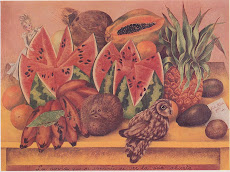Thanks, Ian and thanks, everyone. It’s been a curious project to attempt in some ways, but, for me, the result is extremely satisfying. Juggling the contradictory imperatives of genres, technologies, disciplines, personal geographies, politics and so on, this draft manages to establish coherence and yet retain its beguiling sense of drift through multiple fragments and voices.
A couple of specific comments:
I’m somewhat surprised (though not really unbelieving, to be honest) by the statement (p.1) ‘only a few notable experiments in collaborative writing’. The surprise is partly due to my own disciplinary background (honed in the eighties’ days of ‘memory work’ at the Birmingham Centre for Contemporary Cultural Studies where collective writing as a political statement was de rigeur) and partly because of felicitous connections with geographers who do write collaboratively (for example, with cultural geographers at Royal Holloway, and with Phil Crang, in particular). Perhaps I’ve just been plain lucky? Anyway, for the blog contributors’ interest (and not necessarily to add here), may I offer my own nomination for an interdisciplinary ‘notable experiment’ that has a basis in geography, and one that does involve experimenting with form, mode of representation and differential positioning of the co-writers? Jackie Huggins (indigenous Australian historian), Rita Higgins (Jackie’s mother whose family was forcibly removed from their traditional lands) and Jane M. Jacobs (white geographer) together visit Rita’s birthplace, Kooramindanjie, and each relates a story of her relationship to this profoundly haunted place. The stories are presented in fragments, distinguished by subheadings, different fonts and positioning, almost rubbing alongside each other (and alongside boxed quotations from ‘official’ documents). As Jackie and Jane say, ‘These multiple voices are not intended to reconcile differences, to settle things down; they are intended to activate difference, to ensure the dialogue continues’ (Huggins et al 1997). It seems to me our blogging and its resulting article is written in a similar sprit.
On the other hand, I don’t want to fetishise the technology itself. Obviously, the blog, together with other software, has been extremely useful for communicating across disciplines, cultures and continents and for identifying and following conceptual drifts. Nevertheless, it is only a tool. As in the Kooramindanjie example, written in the pre-blog-Facebook-twitter-etc age, it is the idea of collective writing that is important, and a ‘collective’ that doesn’t assume the ironing out of all differences, the adoption of a uniform ‘voice’ or a uniform direction of argument. Here too, perhaps it’s the continuance of ‘dialogue’ – with all its shifts, continuities, ambivalences, outright differences – that really counts?
Now to do an intellectual/stylistic about-turn … sort of. Like Heike, I love fragments – that sense of postmodern slipperiness about where arguments will take you; that sense you’re relieved of the obligation to make everything fit neatly. On the other hand, I also want a comforting sense of order – a pattern in the fragments; discernible narrative threads, however messy, tangled or loose these might seem. I think Ian has picked up on these in creating the article (in his unraveling/rejoining/repositioning chunks of conversation). After all, an article is different from a blog or potential readers simply need the appropriate link. Personally, I would like to see this shaping and polishing taken a step further with fragments of subheadings indicating where a new thread of argument gathers force (not too aggressively, mind you, just slipped in (writing together in public … borders, fragments, loose ends … things that travel …veils and fetishes … whose organic food, whose food? … victims and violent consumption … reflexively eating the ‘other’ … ‘other’ animals …‘dirty’ politics and ‘visceral imaginaries’ … writing across borders or some such). On the other hand, I wouldn’t want to be too prescriptive, and perhaps the only thing needed, after all, is my trusty highlighter?

No comments:
Post a Comment